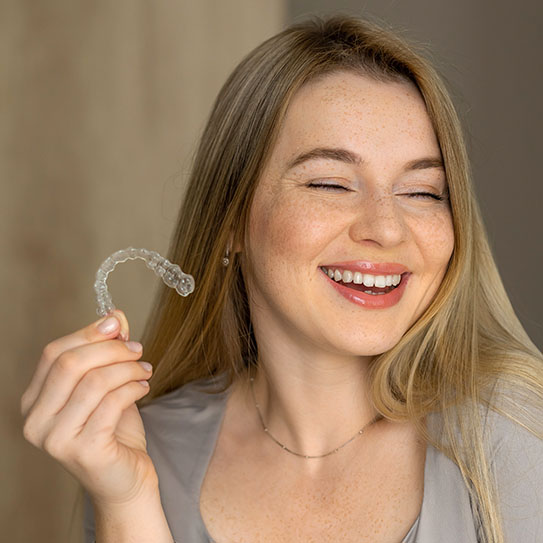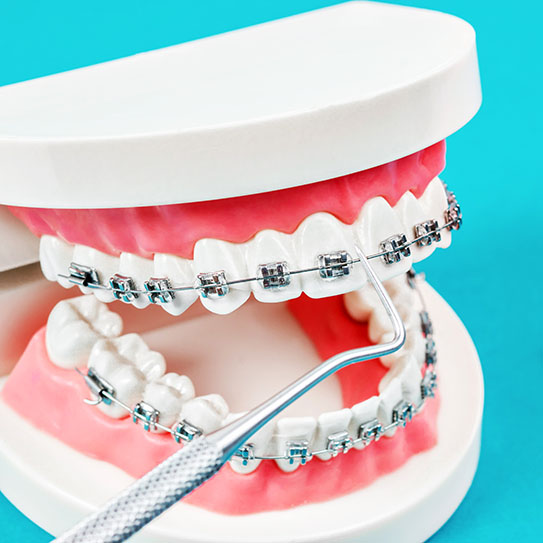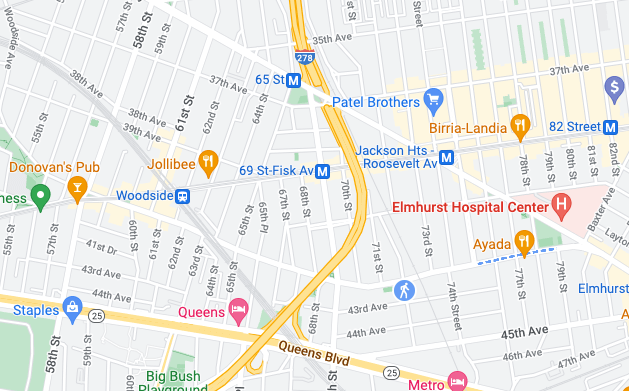Invisalign Care Tips
November 11th, 2025

Keeping Your Aligners Clean and Clear
Choosing Invisalign is an exciting step toward achieving the smile you've always wanted. These clear aligners offer a discreet, comfortable alternative to traditional braces, but they do require proper care and maintenance to ensure the best results. Whether you've just started treatment or you're still considering Invisalign, understanding how to care for your aligners is essential. If you're searching for an "orthodontist near me" to guide you through the process, Bruno Braces in Woodside offers expert care and support for Invisalign Queens NY patients.
Here are some essential tips to help you get the most out of your Invisalign treatment.
Keep Your Aligners Clean
One of the most important aspects of Invisalign care is keeping your aligners clean. Because you wear them for 20-22 hours a day, bacteria and plaque can build up on the plastic surface. Clean your aligners every morning and evening by gently brushing them with a soft-bristled toothbrush and lukewarm water. Avoid using hot water, as it can warp the plastic and affect the fit.
You can also use clear, antibacterial soap or special Invisalign cleaning crystals to keep your aligners fresh and odor-free. Never use toothpaste to clean your aligners, as it can be abrasive and cause tiny scratches that make the plastic appear cloudy.
Maintain Excellent Oral Hygiene
Your teeth should be clean every time you put your aligners back in. This means brushing and flossing after every meal before reinserting your trays. If you don't, food particles and sugars can get trapped between your teeth and the aligners, increasing the risk of cavities and gum disease.
Always carry a travel toothbrush and floss with you so you can maintain your oral hygiene routine even when you're away from home. If brushing isn't an option, at least rinse your mouth thoroughly with water before putting your aligners back in.
Wear Your Aligners as Directed
For Invisalign to work effectively, you must wear your aligners for at least 20 to 22 hours per day. The only times you should remove them are for eating, drinking anything other than water, brushing, and flossing. Consistency is key — skipping hours or forgetting to wear your aligners can delay your treatment and affect your results.
Set reminders on your phone if you tend to forget, and always store your aligners in their protective case when they're not in your mouth. This prevents them from getting lost, damaged, or accidentally thrown away.
Avoid Eating or Drinking with Aligners In
One of the great benefits of Invisalign is that you can remove your aligners to eat, which means no dietary restrictions. However, you should never eat or drink anything (except water) while wearing your aligners. Food and beverages can stain the plastic, and sugary or acidic drinks can get trapped against your teeth, increasing the risk of decay.
If you're tempted to sip coffee or tea with your aligners in, resist the urge. Even clear liquids can cause discoloration over time. Always remove your aligners before eating or drinking, and clean your teeth before putting them back in.
Store Your Aligners Properly
When you're not wearing your aligners, always store them in their case. Leaving them out in the open can expose them to bacteria, and they can easily get damaged or lost. Don't wrap them in a napkin or tissue — this is one of the most common ways aligners end up in the trash.
Keep your aligner case clean as well by rinsing it regularly with soap and water. This helps prevent bacteria buildup and keeps your aligners hygienic.
Handle Aligners with Care
Invisalign aligners are durable, but they can crack or break if mishandled. Always remove them carefully using both hands, starting from the back teeth and working your way forward. Avoid using excessive force, and never bite down on your aligners to seat them — use your fingers instead.
If your aligner becomes damaged, contact your orthodontist right away. Wearing a cracked or broken aligner can interfere with your treatment progress.
Attend Regular Checkups
Even though Invisalign requires fewer office visits than traditional braces, regular checkups with your orthodontist are still essential. These appointments allow your orthodontist to monitor your progress, ensure your teeth are moving as planned, and provide you with your next sets of aligners.
If you're looking for an "orthodontist near me" who specializes in Invisalign Queens NY treatments, Dr. Bruno's practice offers personalized care and flexible scheduling to accommodate your busy lifestyle.
Follow Your Treatment Plan
Your orthodontist will provide you with a customized treatment plan, including instructions on when to switch to your next set of aligners. Follow these instructions carefully. Switching too early or too late can affect your results. If you have questions or concerns about your treatment, don't hesitate to reach out to your orthodontist.
We're Here to Help You on Your Invisalign Journey
Caring for your Invisalign aligners doesn't have to be complicated. By keeping them clean, wearing them consistently, and maintaining excellent oral hygiene, you can achieve the beautiful, straight smile you've been dreaming of. If you're considering Invisalign Queens NY treatment or need expert guidance throughout your journey, contact Dr. Robert W. Bruno's office in Woodside today. We're here to help you every step of the way toward a healthier, more confident smile!



